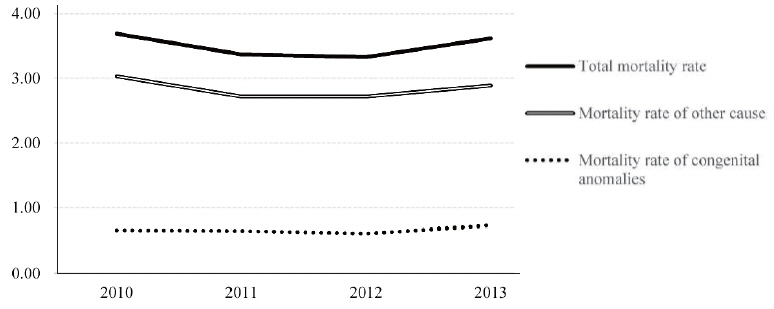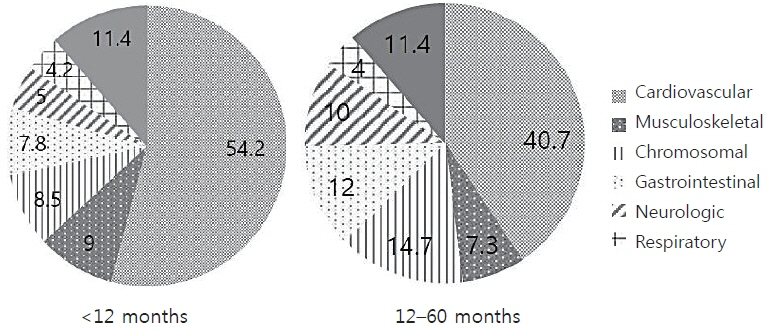Neonatal Med.
2021 Aug;28(3):99-107. 10.5385/nm.2021.28.3.99.
Trends and Characteristics of Mortality Associated with Congenital Anomalies in Korean Children under 5 Years of Age
- Affiliations
-
- 1Department of Pediatrics, Konyang University College of Medicine, Daejeon, Korea
- KMID: 2519772
- DOI: http://doi.org/10.5385/nm.2021.28.3.99
Abstract
- Purpose
Studies have been conducted on the prevalence and infant mortality rate of congenital anomalies; however, studies on child mortality are rare. Therefore, we evaluated the characteristics of deaths associated with congenital anomalies among children born in Korea who died within 5 years of age.
Methods
Birth-to-death cohort linked data of children under the age of 5 years from 2010 to 2013, and statistical data on the cause of death by age from 1999 to 2019, both provided by the Korea National Statistical Office's Microdata Integrated Service, were retrospectively investigated. We investigated the trends and characteristics of mortality associated with congenital anomalies.
Results
Among 1,858,945 children, 6,510 children who died were under 5 years of age, and among them, 1,229 deaths were associated with congenital anomalies, while 5,281 deaths were due to other causes. Deaths associated with congenital anomalies accounted for 18.9% of all deaths. When comparing congenital anomalies by systems, anomalies of the cardiovascular system (52.6%) were the most common. The mortality rate associated with congenital anomalies and those of other causes showed similar declining trends in 21 years.
Conclusion
The mortality rate of congenital anomalies during the first 5 years of life did not increase differently from the prevalence of congenital anomalies but rather decreased. Deaths associated with congenital anomalies accounted for 20.5% of all infant deaths and 12.1% of child deaths, since the major causes of death in infants and children are slightly different, continuous and careful monitoring is required.
Keyword
Figure
Reference
-
1. Chung SH, Kim HY, Kim JH, Choi YS, Lee BS, Kim KS, et al. Changing patterns of congenital anomalies over ten years in a single neonatal intensive care unit. Korean J Perinatol. 2013; 24:11–9.2. Tomatir AG, Demirhan H, Sorkun HC, Koksal A, Ozerdem F, Cilengir N. Major congenital anomalies: a five-year retrospective regional study in Turkey. Genet Mol Res. 2009; 8:19–27.3. Lamichhane DK, Leem JH, Park M, Kim JA, Kim HC, Kim JH, et al. Increased prevalence of some birth defects in Korea, 2009-2010. BMC Pregnancy Childbirth. 2016; 16:61.4. Choi JS, Seo K, Han YJ, Lee SW, Boo YK, Lee SW, et al. Congenital anomaly survey and statistics. Sejong: Korea Institute for Health and Social Affairs;2009: Report No: 11-1351000-000517-12.5. Centers for Disease Control and Prevention. Leading causes of death and numbers of deaths, by age: United States, 1980 and 2016 [Internet]. Atlanta: CDC;2021 [cited 2021 Aug 5]. Available from: https://www.cdc.gov/nchs/data/hus/2017/020.pdf.6. Chung SH, Choi YS, Bae CW. Changes in the neonatal and infant mortality rate and the causes of death in Korea. Korean J Pediatr. 2011; 54:443–55.7. Wen SW, Liu S, Joseph KS, Trouton K, Allen A. Regional patterns of infant mortality caused by lethal congenital anomalies. Can J Public Health. 1999; 90:316–9.8. Rosano A, Botto LD, Botting B, Mastroiacovo P. Infant mortality and congenital anomalies from 1950 to 1994: an international perspective. J Epidemiol Community Health. 2000; 54:660–6.9. Kurinczuk JJ, Hollowell J, Boyd PA, Oakley L, Brocklehurst P, Gray R. The contribution of congenital anomalies to infant mortality [Internet]. Oxford: National Perinatal Epidemiology Unit, University of Oxford;2010 [cited 2021 Aug 5]. Available from: http://www.npeu.ox.ac.uk/infant-mortality.10. Nacher M, Lambert V, Favre A, Carles G, Elenga N. High mortality due to congenital malformations in children aged <1year in French Guiana. BMC Pediatr. 2018; 18:393.11. Roncancio CP, Misnaza SP, Pena IC, Prieto FE, Cannon MJ, Valencia D. Trends and characteristics of fetal and neonatal mortality due to congenital anomalies, Colombia 1999-2008. J Matern Fetal Neonatal Med. 2018; 31:1748–55.12. Jang MJ, Song YH, Yoon JM, Cheon EJ, Ko KO, Lim JW. Mortality rate and major causes of death by gestational age in Korean children under 5 years of age. J Korean Med Sci. 2020; 35:e340.13. Singh K, Krishnamurthy K, Greaves C, Kandamaran L, Nielsen AL, Kumar A. Major congenital malformations in Barbados: the prevalence, the pattern, and the resulting morbidity and mortality. ISRN Obstet Gynecol. 2014; 2014:651783.14. Lee K, Khoshnood B, Chen L, Wall SN, Cromie WJ, Mittendorf RL. Infant mortality from congenital malformations in the United States, 1970-1997. Obstet Gynecol. 2001; 98:620–7.15. Wang Y, Hu J, Druschel CM. A retrospective cohort study of mortality among children with birth defects in New York State, 1983- 2006. Birth Defects Res A Clin Mol Teratol. 2010; 88:1023–31.16. Boneva RS, Botto LD, Moore CA, Yang Q, Correa A, Erickson JD. Mortality associated with congenital heart defects in the United States: trends and racial disparities, 1979-1997. Circulation. 2001; 103:2376–81.
- Full Text Links
- Actions
-
Cited
- CITED
-
- Close
- Share
- Similar articles
-
- Characteristics of Fetal Deaths due to Con genital Anomalies in Korea and Annual Trends from 2009-2020: A Retrospective Study in Korea
- Congenital hand differences: a comprehensive literature review
- Study on Child Mortality among Korean Children
- Trends in Treatment Outcome and Critical Predictors of Mortality for Congenital Diaphragmatic Hernia in a Single Center
- Congenital Anomalies Observed by Autopsies at the Seoul National University Children's Hospital





